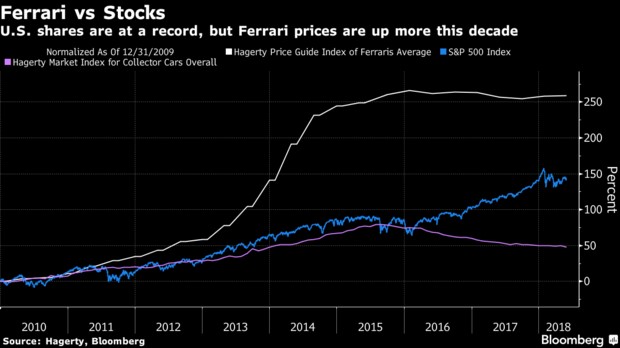“How do we know when irrational exuberance has unduly escalated asset values, which then become subject to unexpected and prolonged contractions?”
Those are the words uttered by former Fed chair Alan Greenspan in December 1996. Spoken in reference to stock markets being too high, it merely states a fact that investors rarely know that they are in an asset bubble as they are too blinded by greed and fear of missing out the next big thing in the market.
As U.S. stock markets keep taking out new highs, other not-so-subtle signs of growing exuberance are emerging.
One worrying trend is that high-end buyers appear too willing to pony up even in these frothy markets, a trend that’s likely to push asset prices even higher. Case in point — a 1962 Ferrari 250 GTO by RM Sotheby's recently sold for a record $48.4 million. That’s a good 25 percent higher than the former record of $38.1 million fetched by a 1963 model in 2014.
If you are thinking that’s an isolated case, you are wrong.
The S&P 500 might have staged the longest and most comprehensive expansion in stock history after racking up gains of 158 percent in this decade. Yet, it’s got nothing on the vintage Ferrari market, which has tripled over the timeframe.

(Click to enlarge)
Source: Bloomberg
But exuberance has not just shown up in the car market. In December 2017, Saudi crown prince Mohamed bin Salman forked over $450 million for a Leonardo Da Vinci painting, the most ever for a piece of fine art. Related: Telcos Caught Between Big Government And Customer Privacy
These growing signs of exuberance have some market observers freaking out. Shane Oliver, Sydney-based investment strategist at AMP Capital Investors Ltd., says not to ignore them:
"Exuberance is back in a big way," Oliver told Bloomberg. "The fact that people are paying record amounts for Ferraris and paintings and share markets are at record highs causes me to be a little bit more cautious."
Possible Causes of Market Crash
Of course, the market is not about to crash just because some tycoon with cash to burn bought a classic piece of art for a prince’s ransom.
Basically markets crash when investors become too cozy and too confident--feeling safer than they ought to.
Unfortunately, this appears to be the case right now. CNN’s Fear and Greed Index (VIX) gauge has moved from fear a couple of months ago to extreme greed currently.

(Click to enlarge)
Source: CNN Money
So what will cause the next market crash? Certainly not old age. Bull markets die of fright rather than through advancing years.
The weakest link in the market chain right now appears to be high debt levels. The markets are overburdened with debt wherever you look. U.S. household debt has already hit an all-time high at more than $13.2 trillion. Mortgages account for the lion’s share of that at $8.9 trillion.
Related: New Deal Boosts Uber Valuation By $10 Billion
Meanwhile, student loans have ballooned to a $1.5-trillion crisis. More than 10 percent of these loans are 90+ days delinquent, worse than even subprime auto loans, which have a delinquency of 9.7 percent.

(Click to enlarge)
Source: Quartz
Auto loans also make up a large chunk of household debt. That’s the case because families are buying more expensive vehicles and taking longer to pay them off. Average duration for auto loans now exceeds 67 months. With average interest rates at 5.11 percent (16.27 percent APR for subprime borrowers) and average loan size of $29,154, the average American is paying $38,000 for a $29,000 car.
But worst of all is an expanding federal deficit which is expected to exceed a trillion dollars soon and hit two trillion in a matter of years. That’s just the perfect backdrop for Treasury rates to continue climbing, which is likely to cause all manner of problems to diverse sectors of the economy.
By Alex Kimani for Safehaven.com
More Top Reads From Safehaven.com

















